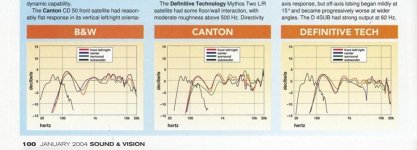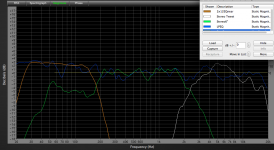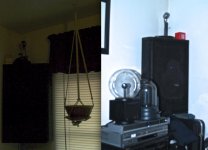Hello.
This seems to me like a very thouroughly engeneered speaker:
WaveWall-182 Wandlautsprecher mit Wavecor WF182BD10 & TW030WA09
here is the kit for sale: Strassacker, Komponenten: Lautsprecher, Frequenzweichen, Bauelemente
For me a surprising amount of bass from a smalish enclosure.
Regards
Agreed.
The shallow cabinets will reduce the wall bounce somewhat. Still there as -4 at 250 Hz, but not so bad.
But none of these were designed for near wall mounting in the way we are discussing: able to remove the effects of the back wall bounce.
All will have the large dip from dual path lengths.
No, but Duntech had the PCL-3 which hung on the wall like a picture frame. It got rave reviews in Audio magazine from Bert Whyte, who may have failed to disclose that he was an investor in the company.
An externally hosted image should be here but it was not working when we last tested it.
Larsen L8
Floorbounce is greatly reduced and wall bounce should be under control
or maybe
Acoustic Illusion Ovation f8

might do the trick.
excellent speakers no matter what.
An externally hosted image should be here but it was not working when we last tested it.
Floorbounce is greatly reduced and wall bounce should be under control
or maybe
Acoustic Illusion Ovation f8

might do the trick.
excellent speakers no matter what.
These
are supposed to have 26 Hz – 22000 Hz (-3 dB, in-room) with Bass reflex from a 170mm paper pulp cone driver (+ 26mm soft dome). I find that hard to believe.
Can't dind any more detailed info on the concept
Regards
Acoustic Illusion Ovation f8
An externally hosted image should be here but it was not working when we last tested it.
are supposed to have 26 Hz – 22000 Hz (-3 dB, in-room) with Bass reflex from a 170mm paper pulp cone driver (+ 26mm soft dome). I find that hard to believe.
Can't dind any more detailed info on the concept
Regards
Both speakers uses the boundary effect / room gain in the bass region.
Not like a vanilla hifi speaker which is designed for being placed outdoors in a winter landscape with 2m of snow on the ground.
Did you read the pdf?
http://acousticillusion.se/wp/wp-content/uploads/2013/02/Ovation_f8_faktablad_4sid_webb.pdf
I've heard them a couple of times and the spec feels very honest.
They cost approx €1500 which i think is a bargain.
the L8:s have a fh at 26Hz and uses two SS 18w/8545
Not like a vanilla hifi speaker which is designed for being placed outdoors in a winter landscape with 2m of snow on the ground.
Did you read the pdf?
http://acousticillusion.se/wp/wp-content/uploads/2013/02/Ovation_f8_faktablad_4sid_webb.pdf
I've heard them a couple of times and the spec feels very honest.
They cost approx €1500 which i think is a bargain.
the L8:s have a fh at 26Hz and uses two SS 18w/8545
No, but Duntech had the PCL-3 which hung on the wall like a picture frame. It got rave reviews in Audio magazine from Bert Whyte, who may have failed to disclose that he was an investor in the company.
An externally hosted image should be here but it was not working when we last tested it.
in fact this particular model was the inspiration for a local hi-fi shop's own product a couple of decades back - my sister had a pair
they sounded quite decent, but were not without their own issues - not only the inflexibility to toe-in for "sweet spot" imaging, but particularly in her case when later mounted on narrow walls flanking a double wide french door opening after one of several interior renovations, and much of the boundary reinforcement was lost.
Ouch! Ouch! Ouch!
Just looking at all of the SHARP cabinet edges hurts my ears.
I suspect that edge diffraction control from cleverly shaped edges would be more important for near-wall speaker placement where there is very little long-delay rear reflection ambience to mix togetner, than from in-room speaker placement where baffle edge diffraction noise gets mixed with a significant amount of long-delay rear wall reflection energy.
SO, is edge diffraction control more or less important for near-wall speaker placement?
Just looking at all of the SHARP cabinet edges hurts my ears.
I suspect that edge diffraction control from cleverly shaped edges would be more important for near-wall speaker placement where there is very little long-delay rear reflection ambience to mix togetner, than from in-room speaker placement where baffle edge diffraction noise gets mixed with a significant amount of long-delay rear wall reflection energy.
SO, is edge diffraction control more or less important for near-wall speaker placement?
you might also find some hints in this article
Wallstreet 3 and 4 - August 2013 - Loudspeakermagazine 2013 | Loudspeakerbuilding
also agree, speakers should either be on-wall or have a bit more distance, too bad we dont all have 50m² living rooms.... definitely need to upgrade my flat as well
Wallstreet 3 and 4 - August 2013 - Loudspeakermagazine 2013 | Loudspeakerbuilding
also agree, speakers should either be on-wall or have a bit more distance, too bad we dont all have 50m² living rooms.... definitely need to upgrade my flat as well
I agree. The notch from the rear wall reflection is not an audible issue. If you compensate for it by eq it will become a coloration problem though.Of course the sharp notch issue is pretty much a technical measurement one and hardly an audible issue.
The BSC changes though are have to be measured and maybe corrected outside of that its not a big deal at all in having near wall speakers.
The best way to deal with the notch is to add sufficient damping material behind the speaker on the wall, like rock wool or something, that affects lower frequencies.
The proximity effect of the wall reinforcing lower frequencies as opposed to free space placement probably need to be dealt with.
I agree. The notch from the rear wall reflection is not an audible issue. If you compensate for it by eq it will become a coloration problem though.
The best way to deal with the notch is to add sufficient damping material behind the speaker on the wall, like rock wool or something, that affects lower frequencies.
The proximity effect of the wall reinforcing lower frequencies as opposed to free space placement probably need to be dealt with.
I beg to differ as I have experimented with these and the wall bounce is clearly audible. Its width and depth is significant. With TV type line speakers it is right in the middle of vocal fundamentals and thins out voices considerably. Compensation with EQ is feasible and reduces coloration.
You can try damping but you need considerable thickness. If you space the unit off the wall to get more room for damping then the cancelation frequency lowers and you need more damping thickness!
I beg to differ as I have experimented with these and the wall bounce is clearly audible. Its width and depth is significant. With TV type line speakers it is right in the middle of vocal fundamentals and thins out voices considerably. Compensation with EQ is feasible and reduces coloration.
You can try damping but you need considerable thickness. If you space the unit off the wall to get more room for damping then the cancellation frequency lowers and you need more damping thickness!
Agreed, in such circumstances I've recessed the speakers flush into the wall, and then there's no cancellation.
That's ok, inaudible maybe the wrong word. But since the notch moves in frequency and magnitude depending on the direction of the sound compensating for it by eq actually adds colouration because it is the same in all directions adding sound energy towards the side walls. The ears will expect the notch with the speakers standing against the wall just as a person standing there singing would sound right. Maybe different by comparison but still natural. Adding the artificial chestiness to compensate would confuse more than it corrects. At least in my experience, even with speakers very close to the wall.I beg to differ as I have experimented with these and the wall bounce is clearly audible. Its width and depth is significant. With TV type line speakers it is right in the middle of vocal fundamentals and thins out voices considerably. Compensation with EQ is feasible and reduces coloration.
You can try damping but you need considerable thickness. If you space the unit off the wall to get more room for damping then the cancelation frequency lowers and you need more damping thickness!
That's ok, inaudible maybe the wrong word. But since the notch moves in frequency and magnitude depending on the direction of the sound compensating for it by eq actually adds colouration because it is the same in all directions adding sound energy towards the side walls.
I would rather fix the direct sound if I could. Note that placing a speaker near but just off a boundary creates a notch in the power response. That is, if you integrate all around the system you will see a notch similar to the forward firing direct response notch, except at a marginally higher frequency. This can be seen in the graphs from Allison's paper. This implies that the response would be improved at most angles and can be exactly corrected at the listeners angle.
The ears will expect the notch with the speakers standing against the wall just as a person standing there singing would sound right.
So a person walks into a corner and they sound all tubby, but they don't really sound tubby because we expected that to happen......
Dave,I would rather fix the direct sound if I could. Note that placing a speaker near but just off a boundary creates a notch in the power response.
So a person walks into a corner and they sound all tubby, but they don't really sound tubby because we expected that to happen......
Glad to see the new job has left your humor intact!
My home stereo speakers are sealed using an 8" and a dome tweeter in boxes mounted in the room corners. The boxes are 9.5" deep on the outside corners, 4.5" deep on the inner side, 14" wide by 27" tall. The corners and baffles are rounded to eliminate diffraction.
The measurements below show the raw response of the 8" (green) at about 6" distance and the tweeter (white) at the same distance with their respective passive crossover filters in place, and the sub output (orange) also measured very close to the exit.
The blue trace shows the combined response with EQ at the center listening position near the room center.
The EQ used in the area of interest concerning this thread is -12 dB at 63 Hz, +1 at 80 Hz, -4.5 Hz at 125 Hz, and -6.5 Hz at 160 Hz. The response only varies a few dB over the width of the couch.
At any rate, the "suckout" due to the distance off the wall still seems to be apparent even though I had hoped the "pseudo soffit" speaker baffle would have mitigated the problem, but the end result in the room comes out pretty flat when the L/R and (center) sub are all integrated.
I also found that the hanging pot (normally containing a Jade plant that has been placed behind the drawn window screen for the summer) and the globular plasma discharge units had no measurable effect whatsoever on the response at the listening position, the traces matched almost identically when they were removed.
Aesthetic features without negative acoustical consequence was a welcome test surprise, since Bonnie would not be happy with the potholder anywhere else, and the Illuma Storm and Lightning Fury were positioned for acoustical symmetry ;^) .
Art
Attachments
Last edited:
I beg to differ as I have experimented with these and the wall bounce is clearly audible. Its width and depth is significant. With TV type line speakers it is right in the middle of vocal fundamentals and thins out voices considerably. Compensation with EQ is feasible and reduces coloration.
Hi Dave,
Isn't that cancellation non-minimum phase hence EQ won't work?
You can try damping but you need considerable thickness. If you space the unit off the wall to get more room for damping then the cancelation frequency lowers and you need more damping thickness!
What about placing the speaker on the wall and covering the whole wall or would that be ineffective because the back bounce is caused only by a small area close to the speaker?
What about utilizing the out of phase back wave of a driver? Some kind of active absorber around the on wall speaker?
Hi Dave,
Isn't that cancellation non-minimum phase hence EQ won't work?
I think for the moderate depth dips I've seen that they are minimum phase. If they were not, they are certainly audible and the system will sound better if they are well equalized. This is not conjecture, I did a fair amount of work on this at psb (Vision Sound VS300).
What about placing the speaker on the wall and covering the whole wall or would that be ineffective because the back bounce is caused only by a small area close to the speaker?
It doesn't take a huge area, but the depth has to be sufficient since you need a 1/4 wave thickness for the 1/4 wavelength frequency comparable to cabinet depth. I.e. you always need treatment as deep as the speaker.
What about utilizing the out of phase back wave of a driver? Some kind of active absorber around the on wall speaker?
That is an interesting thought and I did some simulations a few months back. It is pretty similar to the "pitch and catch" subwoofer systems were woofers on the opposite wall are given an out-of-phase and delayed signal to catch(cancel) the wavefront from the initiating subs.
For the simulation you needed to figure out the frequency response of the off wall speaker in the rear firing direction. You match that with a boundary mounted woofer, given an out of phase and delayed signal. You do get a 6dB benefit for the boundary woofer and it only needs to work over a fairly narrow range. You loose the 6dB boundary benefit of the initial woofer, at least if you cancel fully.
It looked great in the simulations but it would be cheaper to just put the woofer on the back side of the cabinet and step up to a three way. The Allison bookshelf speaker was essentially that.
David
The Allison bookshelf speaker was essentially that.
What specific model are you referring to? The only Allison speakers I know had the woofer on top or near floor.
Allison | The Classic Speaker Pages
What specific model are you referring to? The only Allison speakers I know had the woofer on top or near floor.
Allison | The Classic Speaker Pages
It's the Allison 4 that I was thinking about. The woofer on top or on the bak surface would both achieve the same thing.
As with all Allison style approaches, you want a woofer near enough to a boundary that the cancellation null is fairly high. The midrange is far enough from the boundary that its null is fairly low. Cross over between the nulls and both nulls will be in their respective stop bands.
NHT, AR9, and a few others have exploited the principle. On-wall speakers could do the same. If you want low profile you would mount the woofer on the back surface.
Thanks Dave.
I'm trying to wrap my head around this back firing woofer. What woofer and midrange sizes do you have in mind? I'd think there's only little tolerance in how to position the woofer and how large the enclosure can grow without causing problems with resonances and/or diffraction?
I'm trying to wrap my head around this back firing woofer. What woofer and midrange sizes do you have in mind? I'd think there's only little tolerance in how to position the woofer and how large the enclosure can grow without causing problems with resonances and/or diffraction?
- Status
- This old topic is closed. If you want to reopen this topic, contact a moderator using the "Report Post" button.
- Home
- Loudspeakers
- Multi-Way
- Designing principles for near the wall-speakers


